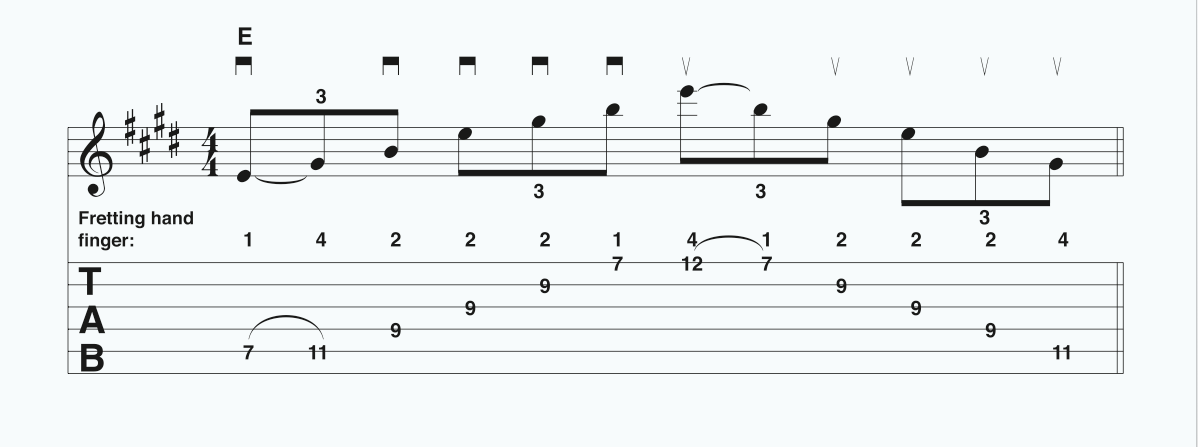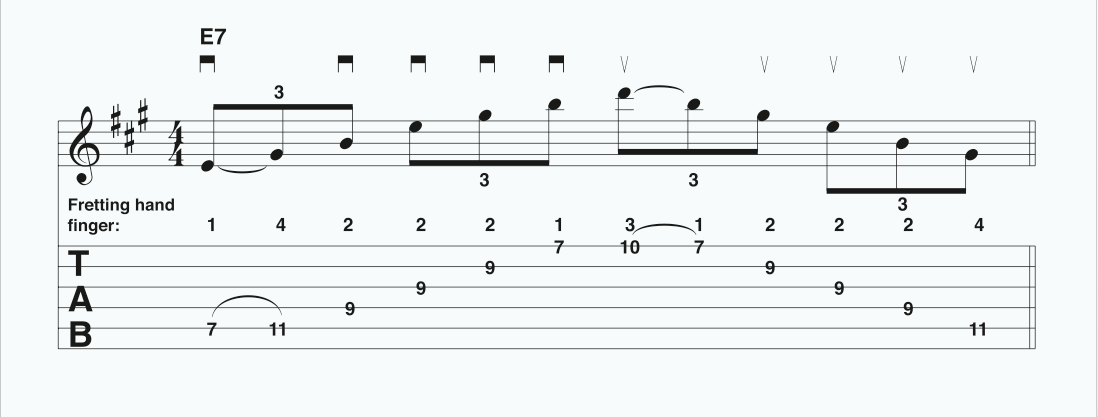Related Tags
Tuition: Clean Sweeping Part One
Combine the sweep-picking techniques you’ve picked up in this series so far as Douglas Noble introduces three challenging two-octave arpeggios to get stuck into.

This month, we draw together the sweep-picking techniques practised over the past few issues into three different two-octave arpeggios, all starting on the E on the fifth string at the seventh fret, and notated as triplets in 4/4 time.
As ever, practise slowly and accurately, and try to make sure only one note sounds at a time. Once you’ve got the notes under your fingers, practise at around crotchet = 60. The advantage of sweep picking is that it enables arpeggios to be played very fast, so ultimately we’re aiming for crotchet = 200, or minim = 100 (at high metronome settings, it can be easier to halve the speed of the click).
The following exercises include suggested fretting-hand fingering below the music notation and above the tablature; every player’s fretting hand is different, so feel free to change the fingering to suit your hand.
 This E major arpeggio starts with a hammer-on on the fifth string and then involves ‘rolling’ the second finger across strings four, three and two (we examined this technique in last month’s lesson). The top of the arpeggio involves a stretch with the fourth finger to E on the top string, 12th fret; leave the first finger on the seventh fret in preparation for the pull-off back to the same fret. The descending part of the arpeggio involves rolling the second finger back across the same strings.
This E major arpeggio starts with a hammer-on on the fifth string and then involves ‘rolling’ the second finger across strings four, three and two (we examined this technique in last month’s lesson). The top of the arpeggio involves a stretch with the fourth finger to E on the top string, 12th fret; leave the first finger on the seventh fret in preparation for the pull-off back to the same fret. The descending part of the arpeggio involves rolling the second finger back across the same strings.

 By changing the high E on the top string, 12th fret in Exercise 1 to D on the top string, 10th fret, we arrive at this E7 arpeggio.
By changing the high E on the top string, 12th fret in Exercise 1 to D on the top string, 10th fret, we arrive at this E7 arpeggio.
Just like Exercise 1, this one involves a hammer-on on the fifth string and then rolling the second finger across strings four, three and two; at the top of the arpeggio, though, leave finger one on the seventh fret whilst stretching to a D at the 10th fret with the third finger in preparation for the pull-off back to the seventh fret. As in Exercise 1, the descending part of this arpeggio involves rolling the second finger across strings two, three and four.

 As in the previous two exercises, this E minor arpeggio starts with a hammer-on on the fifth string, followed by rolling across just two strings with the third finger, leaving the second finger free to play the second string at the eighth fret.
As in the previous two exercises, this E minor arpeggio starts with a hammer-on on the fifth string, followed by rolling across just two strings with the third finger, leaving the second finger free to play the second string at the eighth fret.
Once you’ve nailed these arpeggios, take each one in turn and practise moving up the fretboard one fret at a time as far as possible, then downwards until you end up where you started; how far you can go will depend on how nimble your fingers are.
Then practise moving chromatically down the fretboard as far as possible and back up. This time, the limit will be the stretching ability of your fretting hand. Finally, play the E7 arpeggio from Exercise 2, followed by the A major one from Exercise 1, starting at the 12th fret. Next, play the E7 arpeggio, followed by an A minor arpeggio formed by playing Exercise 3 starting at the 12th fret.

